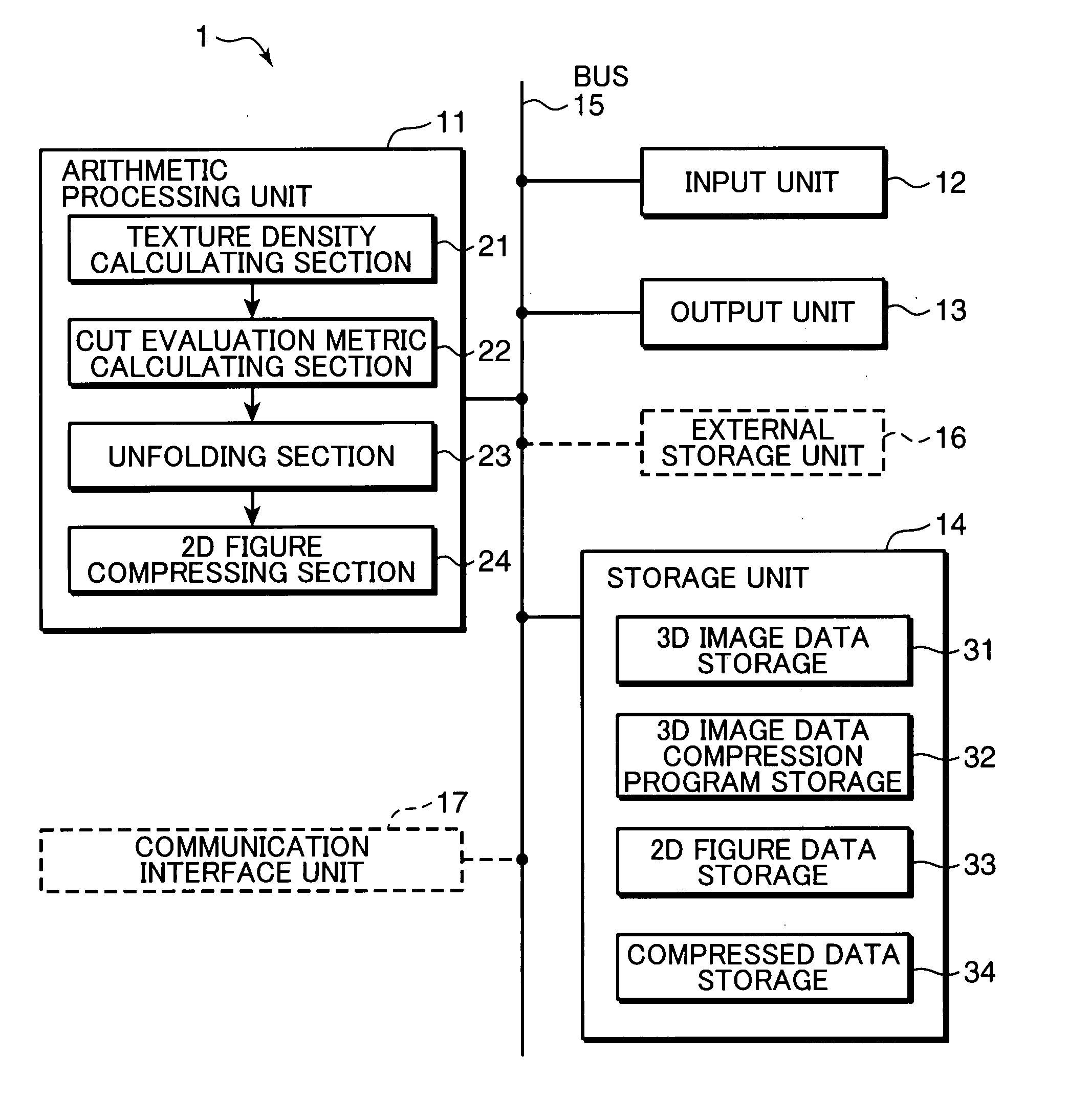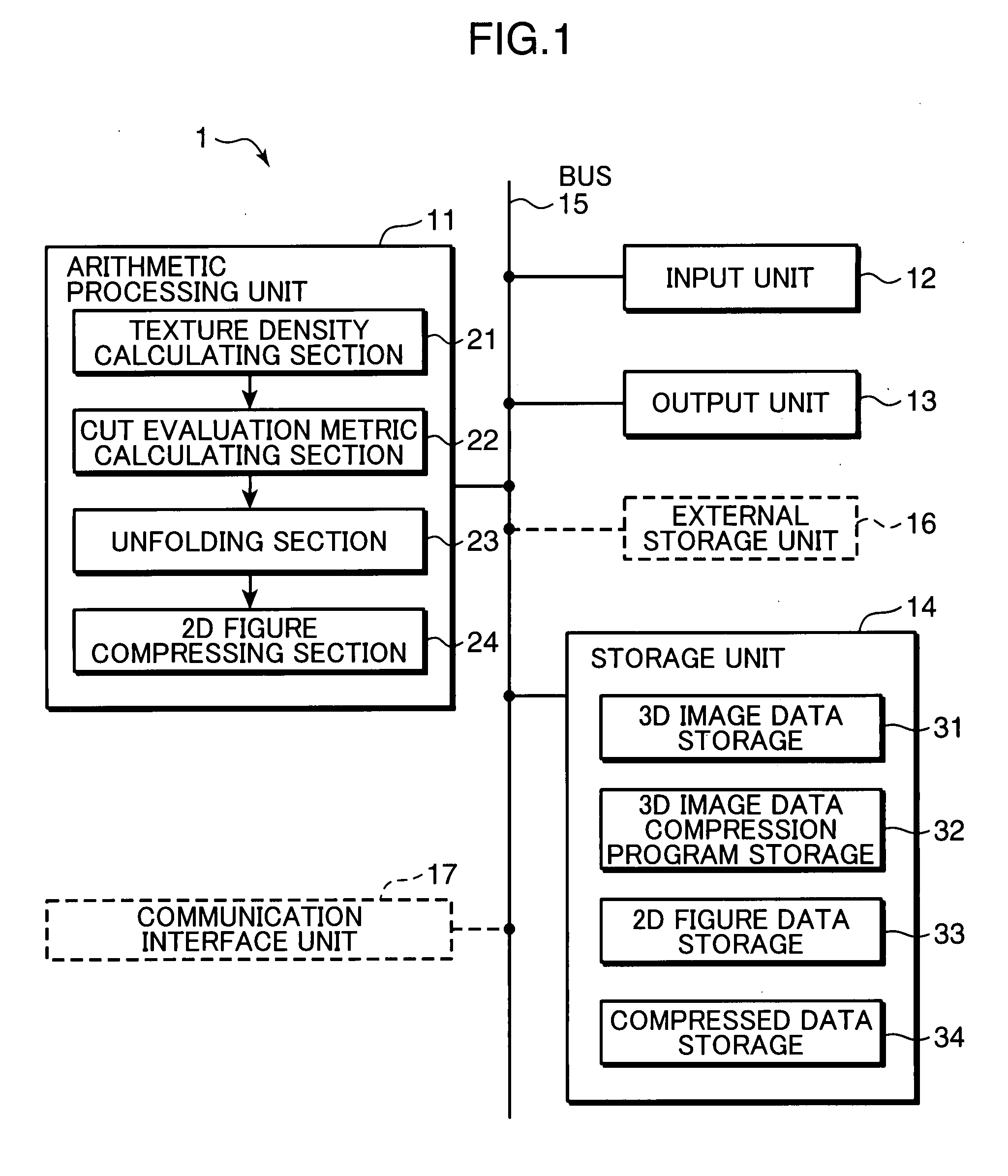Three-Dimensional Image Data Compression System, Method, Program and Recording Medium
- Summary
- Abstract
- Description
- Claims
- Application Information
AI Technical Summary
Benefits of technology
Problems solved by technology
Method used
Image
Examples
first embodiment
Construction of the First Embodiment
[0034] A 3D image data compression system according to this embodiment is a system employing a compression method according to which a cut path is generated by making a cut in a polygon mesh polygonally approximating an object (subject) having an arbitrary shape, the polygon mesh is cut open along this generated cut path and unfolded onto a specified 2D planar figure, a polygon mesh data is correlated with points in the 2D planar figure, and a 2D image compression method is applied to this 2D planar figure.
[0035] This unfolding is performed such that the cut path becomes the outer periphery (outline) of the 2D planar figure, and this correlation is carried out to correlate texture data representing textures (patterns) with polygons of the polygon mesh generated from the polygon mesh data, correlate one vertex (x, y, z) of the 3D polygon mesh to one pixel p (x, y) in the 2D planar figure, and directly correlate the neighborhood relationship of the...
second embodiment
[0086] In the first embodiment described above, the 3D image data compression system 1 generates the cut path based on the texture distributions of the polygons of the polygon mesh so as to reduce the distortion of the polygon mesh reproduced from the compressed data of the polygon mesh data and correlates the polygon mesh data with one pixel within the 2D planar figure based on the texture distributions of the polygons of the polygon mesh and the continuity in the stretch direction in the case of unfolding the polygon mesh onto the 2D planar figure so as to reduce the distortion of the polygon mesh reproduced from the compressed data of the polygon mesh data.
[0087] Here, depending on the shape and texture distributions of a target object, a 3D image obtained by decompressing a compressed data in the case of not considering the continuity in the stretch direction upon unfolding a polygon mesh onto a 2D planar figure might not look largely different to human eyes (difference cannot ...
fifth embodiment
[0116] In the 3D image data compression system according to any one of the first to fourth modes, the 3D image data is the data of frames constituting moving images.
[0117] According to the 3D image data compression system of this fifth mode, the data amount of 3D moving images can be efficiently compressed and compressed 3D moving images with little distortion can be obtained.
(Sixth Mode)
[0118] A 3D image data compression method comprises a cut path generating step of generating a cut path by making cuts in a 3D image generated from a 3D image data; an unfolding step of cutting the surface of an object open and unfolding it onto a 2D planar figure such that the cut path becomes the outer periphery of the 2D planar figure; a correlating step of correlating geometric information and optical information of the 3D image data with points within the 2D planar figure; and a figure compressing step of compressing the 2D planar figure to generate a compressed 3D image data, wherein the c...
PUM
 Login to View More
Login to View More Abstract
Description
Claims
Application Information
 Login to View More
Login to View More - Generate Ideas
- Intellectual Property
- Life Sciences
- Materials
- Tech Scout
- Unparalleled Data Quality
- Higher Quality Content
- 60% Fewer Hallucinations
Browse by: Latest US Patents, China's latest patents, Technical Efficacy Thesaurus, Application Domain, Technology Topic, Popular Technical Reports.
© 2025 PatSnap. All rights reserved.Legal|Privacy policy|Modern Slavery Act Transparency Statement|Sitemap|About US| Contact US: help@patsnap.com



